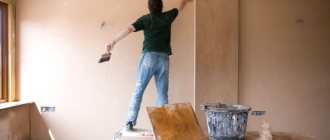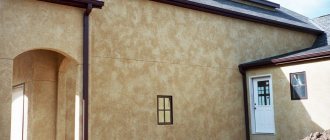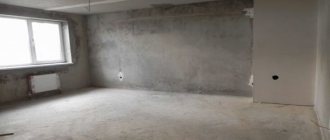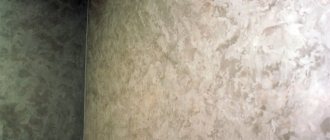A basement or ground floor provides a significant increase in the usable area of the house. They can accommodate storage for workpieces, a workshop or utility rooms. But unlike the above-ground part of the house, basements have their own specifics in arrangement and maintenance. If there is a need to plaster the basement walls, then this specificity will have to be taken into account.
The most common problem is excess room humidity. The fact is that the walls of rooms buried in the ground are subject to different influences than ground floors. There are two reasons why moisture appears in basements.
If there is no or insufficient external waterproofing of the walls of the basement or basement, moisture may enter the premises. For example, the cause may be a sharp rise in groundwater levels - as a rule, this happens in the spring, when the snow melts. Sometimes the flow of water into the basement is so abundant that the basement floods. A common cause of the above problems is the refusal of geological soil surveys.
Condensation is formed from the contact of warm air and cold walls. The same effect can be observed in the bathroom when water vapor settles on the surface of the mirror. If there is no sufficient ventilation in the basement, condensation accumulates abundantly on the walls and ceiling and moisture gradually penetrates deeper.
Excess moisture has a detrimental effect on the foundation - penetrating water, when freezing, breaks the concrete, violating its strength, cracks and microcracks form. The fact is that the grades of concrete used in private housing construction for the construction of foundations do not have a water resistance index, which allows the structure to be constantly exposed to moisture.
Damp and flooded rooms are unsuitable for use, and pockets of fungal mold, which often occur in poorly ventilated, damp basements, are completely dangerous to life and health.
Before equipping a basement or ground floor, it is necessary to identify the cause of excess moisture and, if possible, eliminate it. In each specific case, a whole range of measures is carried out - pumping out water in case of severe flooding, additional waterproofing of the floor, walls and seams, arrangement of drainage and ventilation, drying the room with fan heaters.
Plastering walls is not only a way to level the surface, but also one of the methods of waterproofing. For this purpose, special types of plaster are used, containing various chemical compounds and complexes of mineral additives, which make it possible to reliably isolate the basement or basement from excess moisture.
Preparing walls for plastering is the same for all types of plasters.
- The wall is cleaned of dust, grease stains, traces of old finishing, if any, and checked for cracks, unsealed seams and other places through which water can penetrate into the basement.
- If there are pockets of mold in the basement, they must be removed mechanically, cleaning the surface to the base, and then treating the area of infection with antifungal agents. If there is efflorescence on the surface of the walls, then the surface is also treated with special chemical compounds.
- A primer containing antifungal substances is applied to the surface of the walls, even if there is no mold in the basement. Such prevention will not be unnecessary.
- The composition of the plaster is mixed according to the manufacturer's instructions. Usually the finished solution has a consistency similar to thick sour cream. To apply the plaster, the usual tools for such work are used.
- Initially, cracks, irregularities and seams are filled with the solution, after which the first layer of plaster is applied. Subsequent layers are applied based on the type of plaster and the recommendations of the mixture manufacturer.
- If the plaster takes a long time to dry, you can place one or more conventional fans in the basement. Air movement helps the plaster harden.
Construction and architecture news
- home
- »
- Finishing
- » All about plastering walls in the cellar and basement
Plaster is the most common method of finishing residential premises. In non-residential rooms, such as basements or cellars, this finishing method is used less frequently. People have less experience in this matter, and therefore, if you decide to plaster walls made of concrete, brick or rubble stone in your cellar, then problems may arise in the process due to the specific local conditions. Therefore, if you want the plaster you applied to not begin to peel off the wall a short time after installation, then you need to know certain rules.
Dampness is the main enemy of plaster
Unlike other rooms, the walls in the basement or cellar are buried in the ground. Ideally, the lower part of the house does not reach the groundwater level. However, external waterproofing is still required, since otherwise moisture will penetrate the wall structure, destroying its mineral and reinforcement base. Often, internal insulation (which is not recommended) of the walls is made, in which case they are finished with panels or bricks, rarely using plaster. But if the latter is still used in this damp room, then it may encounter several problems.
- Moisture penetration. The latter may be due to excessive soil moisture or water vapor pressure. In the first case, you can pump out excess water through drainage, but in the second, use waterproofing plaster;
- Condensation. A phenomenon that often occurs in the bathroom can also be severe in the case of a basement or cellar. The reason is the warm air that comes into contact with the surface of the wall, which is cooled by the soil outside. As a result, moisture from the air condenses on the surface and can lead to the destruction of the plaster over time.
Important! As can be seen from the above, moisture can enter the basement from the inside or outside. And this is extremely important for deciding on further finishing. There is a trick to check - polyethylene is attached very tightly to the problem area of the wall, and remains in this state for several days. Afterwards, all that remains is to see from which side the moisture is deposited on it.
Waterproofing methods
There are various ways to protect the surface of walls from moisture, but the most common are coating or fusing.
Both methods are not durable and require periodic updating. Under the natural pressure of external waters, the protective layer swells and peels off. More modern and technological methods include:
- penetrating;
- membrane;
- waterproofing with liquid rubber or glass. For more information on how to waterproof, watch this video:
The choice of waterproofing agent also depends on the foundation material.
When choosing a material, you should pay attention to:
- groundwater level and average annual precipitation;
- presence of a drainage system;
- functional load of the room;
- foundation wall material.
Waterproofing basement walls, regardless of the type of device and spatial orientation, can be carried out with various materials:
| Insulation type | Compound | Mode of application | Specifics and advantages |
| Penetrating | Cement, sand, chemical additives. | Apply on the inside of the walls. The mixture penetrates 0.1 m into the wall material and crystallizes. | Recommended for basements with high groundwater levels. prevents moisture from rising; reduces the risk of corrosion; improves thermal insulation; safe for use and environmentally friendly. |
| Roll | Ruberoid, waterproofing, linochrome. | The material is glued overlapping, the seams are welded with a soldering iron. Bitumen mastic is used for gluing rolls. A screed is poured over the waterproofing. | Used to protect basement floors from groundwater. |
| Liquid glass | An aqueous solution of sodium or potassium silicates. | Applied by coating method | increases resistance to fungi and mold; increases the strength coefficient of walls; reduces the water absorption level to 0. |
What kind of plaster is used in the work?
Cement option
Unlike gypsum compositions, those with a cement base resist moisture much better. They should be used under normal conditions, when the walls in the basement or cellar do not reach the groundwater level, and there is normal ventilation in the room itself.
Waterproofing alternative
The latter can withstand not only humidity, but also direct exposure to water, which is why it is actively used for finishing swimming pools and other bodies of water. Before using the wall, it is advisable to treat it with an antifungal primer, but finally the plaster layer can be protected with a standard cement-sand composition.
Sanitizing composition
A unique composition with a large number of pores, which can significantly increase the area of moisture absorption. At the same time, the latter does not penetrate deep into the plaster and quickly evaporates from the surface. This type of plaster mixture is often called desiccant.
Step-by-Step Guide to Applying Finishes
- If the recessed room was previously finished, then all the old finishing will need to be removed. And the better this stage is carried out, the better the adhesion of the new finish to the surface will become. Try to check the wall for cracks through which moisture can penetrate, as well as poorly secured elements that may fall off along with further finishing;
- The wall is treated with a primer. Try to choose a primer from the manufacturer who created the plaster composition that is applied afterwards. Primer will not only increase surface adhesion, but can also strengthen porous surfaces such as concrete and brick, and also has anti-fungal properties, which is especially important in such damp areas;
- The composition is mixed in accordance with the manufacturer's instructions. The consistency should correspond to thick sour cream. It is important to mix such an amount of composition that you can apply in 1-2 hours, since after that it will begin to set;
- In parallel, a plaster mesh can be applied to the walls to provide higher strength. The latter is also necessary in the case of new basements, which will be subject to shrinkage during the first time after the construction of the house;
- Applying the solution, as well as grouting it with a float, is similar to the work in other rooms and has already been described by us on the website. The work involves standard tools. If sanitizing plaster is used, then there is no need to rub it, as this will block the pores and make all the advantages of the composition meaningless;
- If you plan to further finish the plastered surface, it is better to do this no earlier than after 8 days, since the composition will harden much longer in wet conditions.
The main mistakes when plastering walls
- Incorrect temperature selection.
When applying plaster, the room temperature should be in the range from +5 to +25 degrees. At a lower value, the rate of hardening of the finished solution decreases, and hence its strength. At higher temperatures, some of the water added to the mixture will evaporate and not be enough to form crystals.
- Plastering without preliminary priming.
If some surfaces that absorb moisture well are not primed, some of the water from the mixture may go into the base, which will cause the mixture to dry poorly, which will lead to cracks.
- Failure to comply with the time required for the mixture to dry completely.
It takes up to 24 hours for the primer to dry, and from a week to four to coat the plaster, depending on the air temperature and humidity.
Also, to speed up drying, you cannot use heat guns, since in this case the applied solution may dry out and cracks may appear.
What to do if the material does not dry for a long time
Sometimes it happens that groundwater does not pass into the basement, and everything is in perfect order with the waterproofing, but drying still occurs slowly. In this case, you can install a fan in the room, or even several for large volumes. Providing air movement will speed up the drying process.
Important! We are talking specifically about ordinary devices, and not about fan heaters. The use of the latter may lead to the formation of cracks. But using the latter to dry the walls before carrying out work, on the contrary, is very, very useful.
Types of waterproofing
It is customary to divide types of protection against water depending on the degree of exposure to moisture:
- Anti-pressure. It is produced in cases where there is no drainage system and the groundwater pressure exceeds 10 m. In such a situation, strong continuous protection against water penetration is provided. It is effective if installed outside the basement walls; it is carried out at the time of completion of the foundation work. Under external pressure of water, the waterproofing material is pressed more tightly to the surface of the walls.
- The anti-capillary technique helps protect the underground part of the structure from the penetration of excess moisture and the appearance of dampness. When carrying out this type of work, it is recommended to use penetrating materials.
- Non-pressure. Carried out when there is a threat of temporary (seasonal) flooding. As a rule, for simplicity and speed of work, a solution of bitumen mastic is used.
By properly insulating the basement from moisture, you can significantly save on heating costs, as well as increase the life of the building.
When choosing a material and technology for carrying out work to protect the basement from moisture, it is necessary to take into account the possible adhesion of the building material and insulation. For interior work, experts recommend penetrating materials.
Why does dampness appear on the walls?
The plaster on the walls in basements and cellars will not last long, and sooner or later it will fall off if the walls themselves get wet.
The reasons for this phenomenon and ways to combat them have long been known:
- Condensation _ It occurs due to the temperature difference between outside and inside, and poor ventilation in the room. The outer wall of underground rooms is always cold due to contact with the ground, and if the air temperature inside is much higher, and there is no hood or it does not work, moisture will certainly condense on the walls, which gradually destroys both the plaster layer and the wall materials. Moreover, constant dampness leads to the formation of fungus and mold, which are harmful to human health. Therefore, storing food in such premises becomes simply dangerous.
- Penetration of moisture through walls . This happens when the soil outside the cellar is oversaturated with water, and the instructions for installing external waterproofing are violated or missing altogether.
For reference. The problem can be eliminated by restoring it and arranging drainage, but this is very labor-intensive work. It must be carried out during the construction phase of the building, and after its completion it is often simply impossible to do.
Materials for plastering cellars and basements
Ordinary cement plaster (see Which plaster is better - gypsum or cement: characteristics of building mixtures) can be used to finish the walls of underground storage facilities only if the external waterproofing is done well and the room itself is equipped with a ventilation system.
It will hold securely and perform its functions even underground, not adjacent to the foundation of the house. Such storage facilities are often found in country houses: they are located under the kitchen or other room, from which they enter the underground through a hatch in the floor.
The vault itself is formed by four solid walls, none of which are in contact with the foundation.
If its depth does not reach the level of groundwater, then in the presence of ventilation it always maintains normal air humidity. Therefore, ordinary plaster on a grid in a basement of this type is the most affordable and budget solution.
Causes of excess moisture in the cellar
Plastered walls in a cellar will not last long in this condition if the walls themselves are constantly covered with moisture.
The causes of moisture and methods to combat this phenomenon are very well known:
Condensation Formation
Appears due to differences in temperature levels on the surface and inside the room, as well as lack of air ventilation. The outer wall of the cellar will always be cold, since it is in direct contact with the cold ground. If the internal temperature is much higher than the ambient temperature, then condensation is inevitable.
Water penetration through the wall
This occurs when the soil outside the premises is oversaturated with water, and the instructions for installing the waterproofing outer layer have been damaged or are simply missing.
Materials for plaster
IMPORTANT!! Plastering walls is best done with a high-quality outer layer of waterproofing, and there is a ventilation system in the room itself.
Reliability of holding the plaster can be ensured in a cellar that is not adjacent to the foundation of the house. Such underground storage facilities are often equipped in houses located outside the city, with access to them through a hatch in the floor. The storage structure is made of four walls, which are built without contact with the foundation of the building.
If the basement is not located at the groundwater level, then the air humidity in it is maintained at a normal level. Therefore, it does not require the use of special plasters for rooms with high humidity, and it is quite possible to get by with regular plasters.











